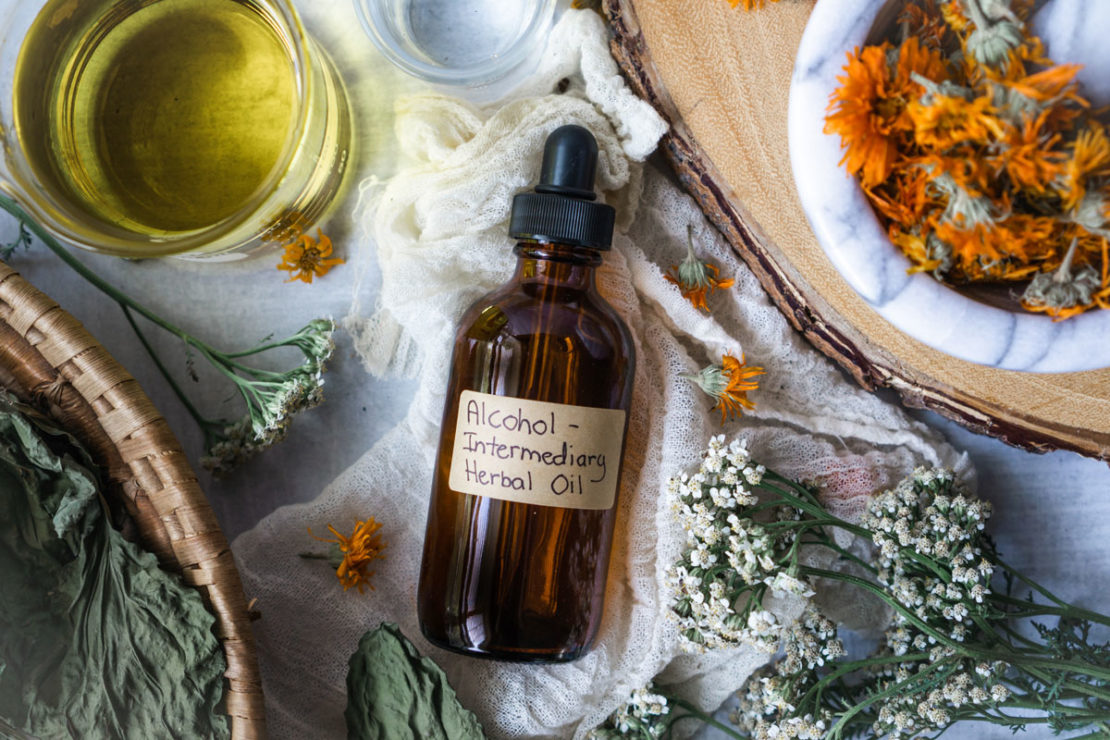
How to Make Alcohol Intermediary Herb-Infused Oils
Have you heard the phrase, there’s more than one way to garble an herb? If so, you can certainly apply that to herbalism when it comes to making various herbal preparations. There are many variations and methods of making herbal infusions, tinctures, syrups, and yes, even herb-infused oils—there’s something for everyone’s skill level and preference.
Some of these variations speed up the time it takes to make a preparation, some cut down on complicated measurements, and others work to create a more potent end product.
In this post, I will share a lesser-known way to make herb-infused oils. These oils are known as “alcohol intermediary herb-infused oils.” This preparation will not only take your herbal preparation skills up a notch, but will also help save you time, increase the shelf life of your oils, and create a strong oil that will help you get the results you’re looking for.
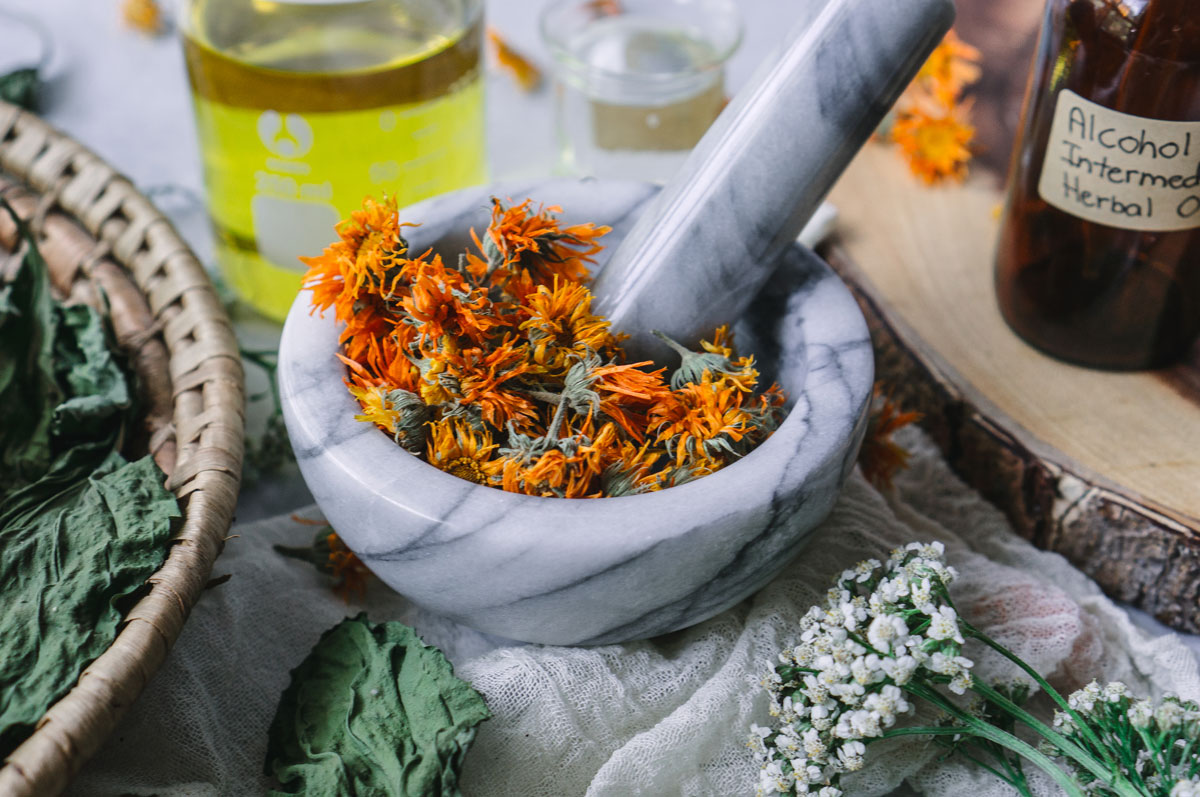
Herb-Infused Oils: A Must-Have Preparation for Every Home Apothecary
Herb-infused oils are a basic staple of the home apothecary. These plant preparations carry the many beneficial properties of the herbs lovingly infused into them, and they have a wide variety of uses. Herb-infused oils are often used externally on the skin, but some are used internally or for culinary purposes. Herb-infused oils can be applied directly to the skin, or they can be further processed into herbal salves and herbal creams.
Oil is a solvent that can easily extract gums, resins, and oleoresins while partially extracting volatile oils, mucilage, alkaloids, and other active constituents (Cech, 2000). The temperature of the oil will also influence the extraction of specific plant constituents, so you’ll want to do some research to determine the best way to obtain the beneficial properties of the plant you’re using.
Infused oils can be made using fresh or dried herbs. You can learn how to make an herb-infused oil with dried herbs in How To Make Herb-Infused Oils, and you can learn how to make an herb-infused oil with fresh herbs in How To Make Fresh Dandelion Blossom Oil.
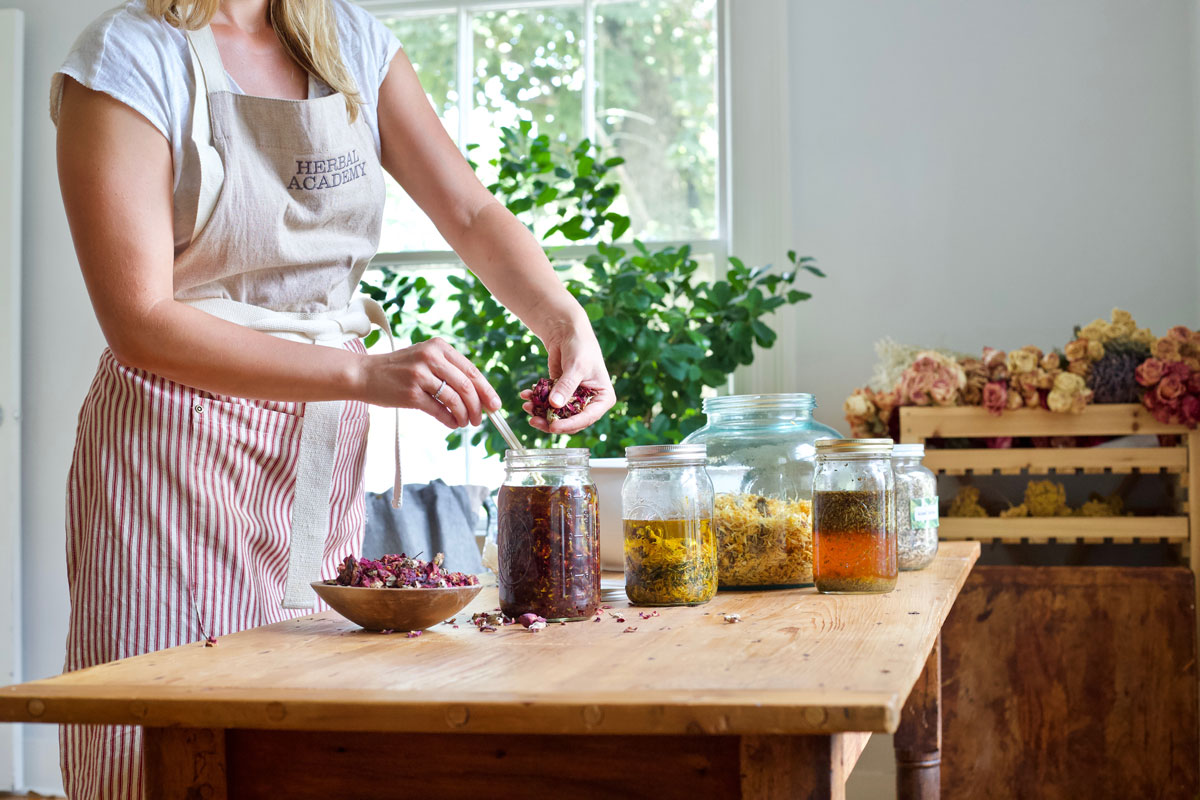
Creating More Potent Herb-Infused Oils
In my herbal practice, when I make a preparation, I want it to work well; therefore, I want it to be strong and potent. To do this, I need to know how to make my preparations in a way that will yield a high-quality extraction.
When it comes to basic herb-infused oils, the first step to achieving a potent oil extract is to research the herb you are using and identify the constituents that will be extracted in the oil. (Making Plant Medicine by Richo Cech and The Herbal Medicine-Maker’s Handbook by James Green are two great resources to help you get started.) Knowing this information will help you to see whether you need to use a warm or cool infusion process to get the best extraction. For example, if you are trying to extract the resins of myrrh (Commiphora myrrha), you will want to keep your oil warm, but if you are trying to extract the mucilage of plantain (Plantago spp.) leaf, you’ll get a better extraction with a room temperature oil.
The next step is to expose as much surface area of your herb as possible. This ensures the oil comes into more contact with the plant material and will do a better job extracting the herb’s constituents. To do this, you will chop or grind your herb into small pieces, even powdering it if desired.
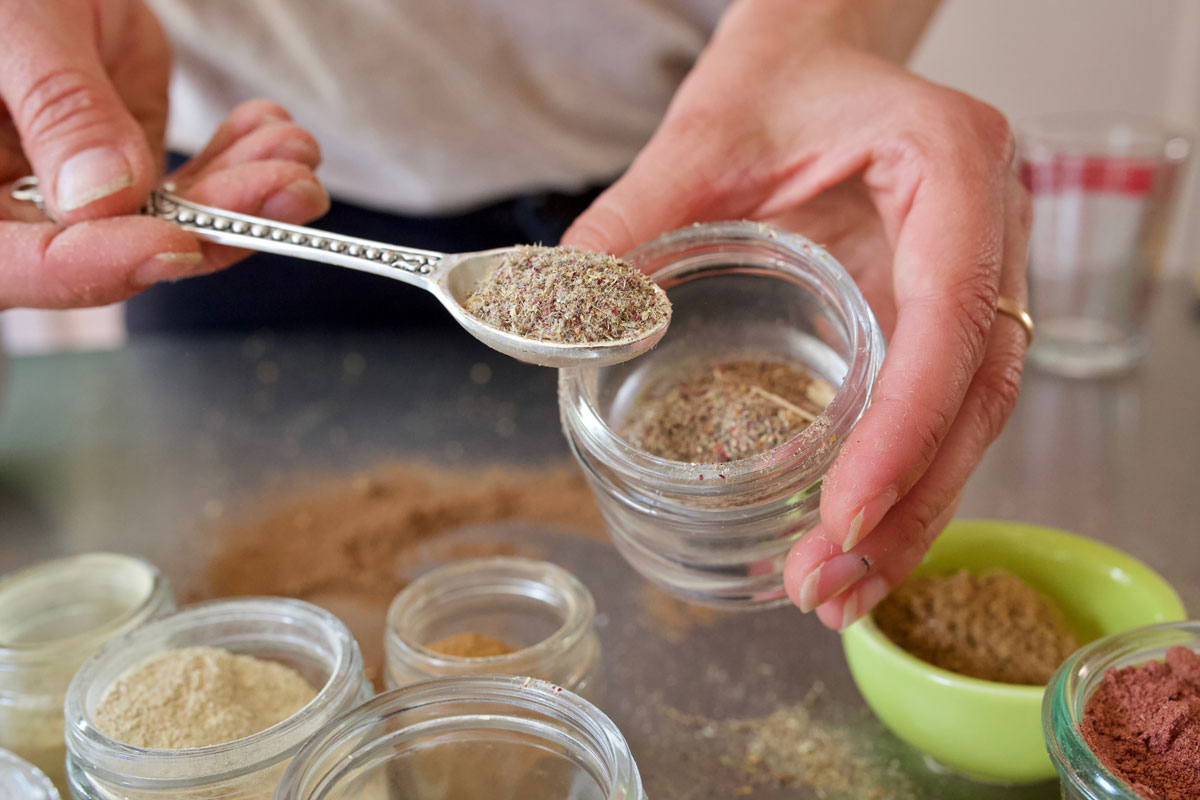
Lastly, you’ll want to allow your oils time to macerate to achieve a strong preparation. Time will vary depending on the preparation method you choose, such as a solar infusion, a stove-top infusion, or the conventional 6-week oil infusion.
But what if you don’t have weeks to wait for your oil to macerate, or what if you don’t have time to watch it on the stove for several hours one day? Did you know there is another way to get a potent herb-infused oil in a short amount of time?
These oils are called alcohol intermediary herb-infused oils, and below, I will explain how you can use this method to make an herb-infused oil. You’ll also find some herbal formulas that can be used with this herbal preparation method that are a perfect fit for the upcoming summer months!
Grow Your Herbal Preparations Skills with Alcohol Intermediary Herb-Infused Oils
Alcohol intermediary herb-infused oils are quicker to make than the common 6-week herb-infused oils. These oils can be made from start to finish in just over a day, so if you’re in a hurry for an herb-infused oil, this oil-infusion method may be a fit for you!
Another benefit to alcohol intermediary herb-infused oils is that it helps yield a more potent preparation due to the use of alcohol. While this type of oil preparation can be used with most dried herbs, it works best with herbs that have a good amount of alcohol-soluble properties, such as resins, balsams, camphors, essential oils, alkaloids and alkaloidal salts, glycosides, organic acids, most coloring matter, and almost all acrid and bitter plant constituents (Green, 2000). In addition, it is ideal if the herbs are not particularly oil-soluble, such as arnica (Arnica montana) flower, cultivated goldenseal (Hydrastis canadensis) root, or chaparral (Larrea tridentata) aerial parts.
Alcohol intermediary herb-infused oils also have a long shelf life, which is another benefit to this type of preparation. While most herb-infused oils are shelf stable for 12 months when stored properly and kept clean during use, alcohol intermediary herb-infused oils have a longer shelf-life due to the use of alcohol, which reduces the likelihood of microbial or mold growth in the oil. Speaking of microbial growth and shelf-life—alcohol intermediary herb-infused oils should be made with dried herbs only—not fresh herbs. Making herb-infused oils with fresh herbs adds extra water to the oil and will decrease shelf-life.
If you find yourself wanting to take your herbal preparation skills to the next level, why not give alcohol intermediary herb-infused oils a try?
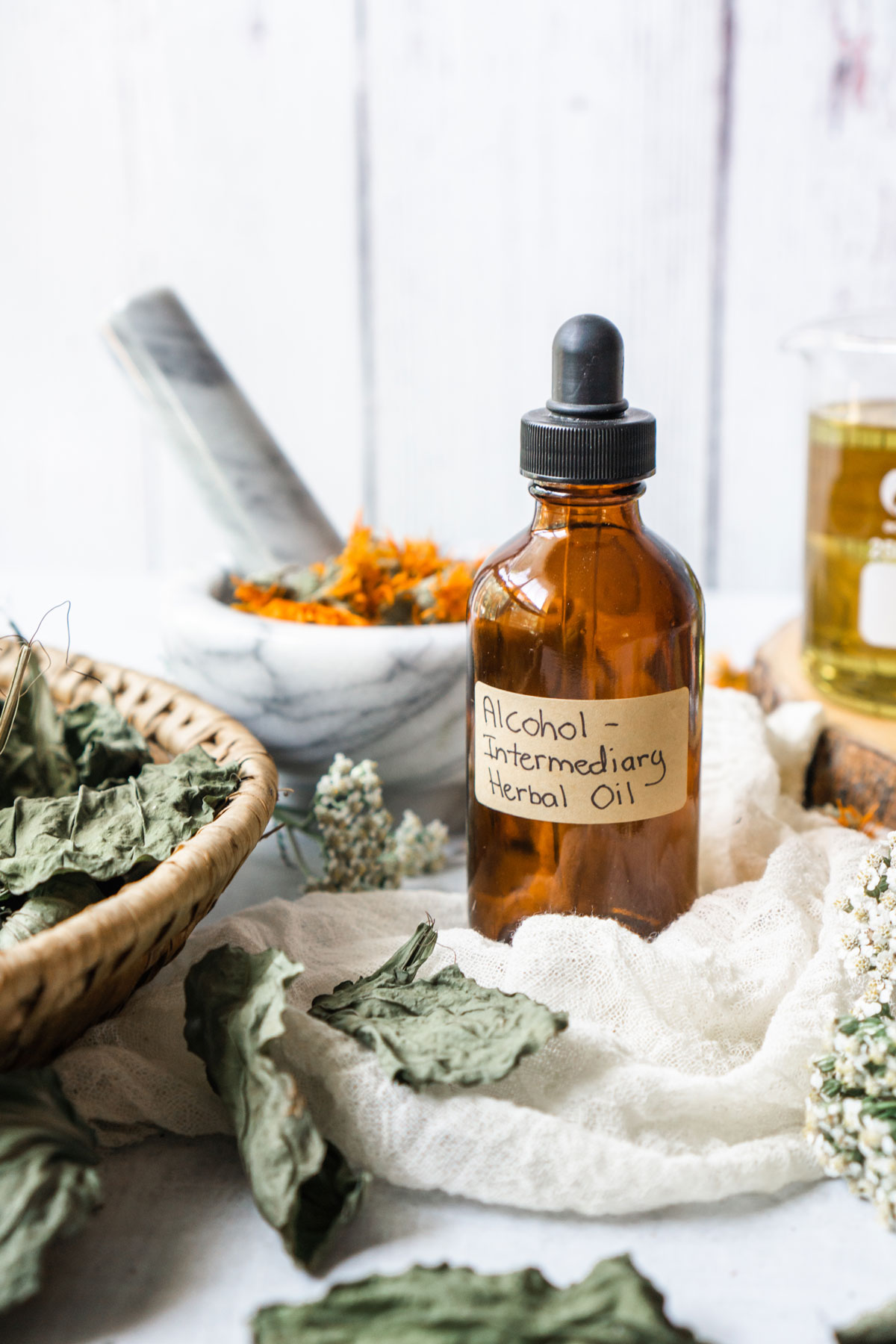
Basic Alcohol Intermediary Herb-Infused Oil
Alcohol intermediary herb-infused oils are quite easy to make. There are several variations you can follow when making these oils. I will explain more about these variations as we go through the following steps so you can choose what works best for you.
1 oz dried herb
½-1 oz 190-proof alcohol
8 oz carrier oil of choice (olive, sweet almond, grapeseed, etc.)
Clean glass canning jar and lid
Parchment paper
Coffee grinder
Blender
Stainless steel sieve
Cheesecloth or muslin cloth
Unbleached coffee filters
Amber-colored glass jar
- First, weigh out 1 ounce of dried herb using a kitchen scale, and measure out ½ to 1-ounce of alcohol in a glass measuring cup. If you choose to take the folk herbalist approach, then you will fill a glass canning jar ½ full with herb material.
- Next, you can grind the herb into a coarse powder using a coffee grinder before combining it with the alcohol, or you can skip that part and mix the dried herb and alcohol directly together. As I mentioned before, grinding your herb will yield a more potent preparation because it increases the surface area of the herb, allowing your solvent to come into more contact with the plant matter. However, using a powdered herb will take a little more work to strain the powder from the oil in the end, but the extra work is worth it, in my opinion. I’ve also found that less alcohol is needed to moisten the herb if it’s first ground into a powder. If you’re eyeballing your measurements, after grinding your herb, your canning jar should be about ¼ full of powdered herbs.
- Now it’s time to add your alcohol. If you ground your herbs into a powder, add a ½-ounce of alcohol to the powder—just enough to dampen it. Feel free to use a fork to blend the herbs and alcohol together until the mixture is loose and crumbly. If you are not grinding your herbs, it’s a good idea to start by adding ½-ounce of alcohol to the herbs and mixing them. If you have fluffy herbs like arnica (Arnica montana) or calendula (Calendula officinalis) flower, you may need to add some more alcohol (up to 1-ounce) to moisten the herbs thoroughly. Again, your herbs should be damp, but you shouldn’t be able to squeeze or press liquid out of them.
- Once your herbs and alcohol are combined, place a piece of parchment paper between your glass canning jar and its lid, cap the jar tightly, and let this sit for 24 hours so the alcohol can extract the alcohol-soluble properties from the herbs.
- After 24 hours, transfer your herb and alcohol mixture to a blender. Measure out 6 to 8 ounces of a carrier oil of your choice and add that to the herb mixture. When I grind my herbs into a powder, 6 ounces of oil works well for me. For fluffier herbs, 8 ounces or more may be needed. Blend this mixture on medium speed until the blender feels warm.
- Now you can choose to transfer your mixture to a double boiler to heat over low heat for a few hours or move on and strain it. Heating your alcohol intermediary herb-infused oil is beneficial for two reasons. First, it can help to further extract constituents from the plant material, and secondly, it can help reduce the alcohol content in your final oil. This step is entirely up to you. If I have time, I like the added value of the heat, but if I’m short on time, I skip this step.
- Next, you will need to strain the herb from the oil. When working with powdered herbs, I like to strain my oils a few times to remove all of the herbs and any sediment from the oil. This extra effort not only makes for a nicer end product, but it can also help to extend the shelf-life as bacteria is more likely to grow when sediment is left floating around in the oil. To start, I strain the herb and oil mixture through a fine-mesh sieve lined with a couple of layers of cheesecloth. Gather up the edges of the cheesecloth to make a bundle and squeeze all the oil from the herbs. Compost your herbs.
- Next, I strain the oil through an unbleached muslin bag. This helps to catch any sediment that made its way through the cheesecloth. You can also squeeze this to speed up the process. Lastly, I’ll strain the infused oil one final time through an unbleached coffee filter to further remove any sediment. If you did not powder your herbs, straining your mixture through a fine-mesh sieve lined with a couple of layers of cheesecloth should be sufficient to remove any herb particles from the oil.
- After your infused oil is strained, you’ll want to bottle it in a labeled amber-colored bottle to protect it from light and store it in a cool location. Both of these things will help extend your oil’s shelf life.
3 Alcohol Intermediary Herb-Infused Oil Formulas to Make This Summer
Now that you know how to make alcohol intermediate herb-infused oils, let me share some specific herbal formulas that may come in handy this summer!
In the following recipes, you may notice that percentages of herb are called for instead of standard measurements or parts. Don’t let that confuse you. Herbal formulas are often written with percentages to keep things clean and simple. You can easily convert each percentage to parts making it easier to blend together. What should you use as a part? Well that depends on how much herb-infused oil you want to make. Remember, you only need 1 ounce of powdered herb to 8 ounces of oil so chances are, your parts will be small.
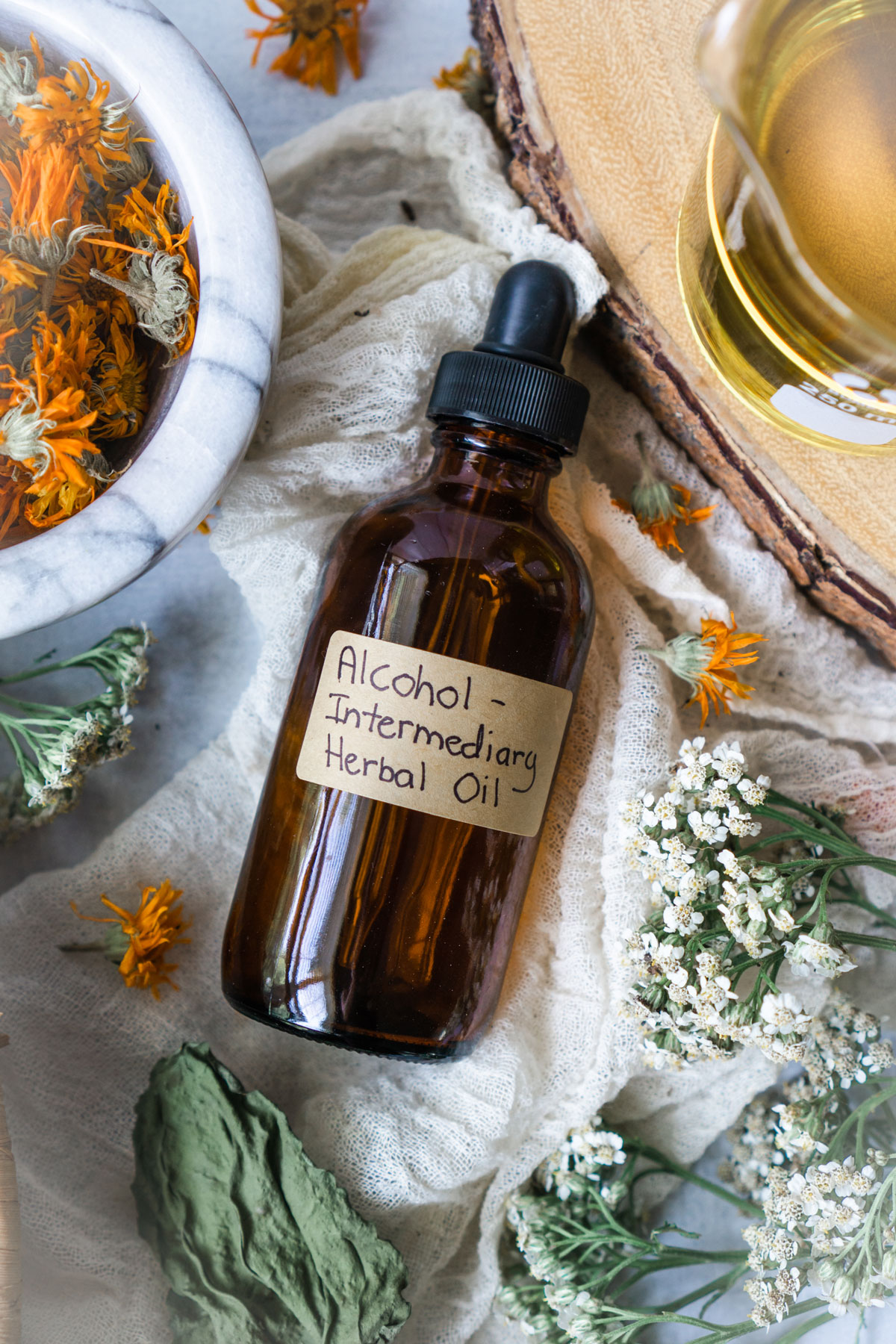
Cuts & Scrapes Wound Oil
This blend of herbs is excellent thanks to its antimicrobial properties. Use this infused oil as-is on any minor burn or wound, or turn it into an ointment with a touch of beeswax if you prefer.
Ingredients:
60% calendula (Calendula officinalis) flower
20% plantain (Plantago spp.) leaf
10% yarrow (Achillea millefolium) flower
10% lavender (Lavandula angustifolia) flower
Jethro Kloss’ Herbal Oil
Do you want the benefits of Jethro Kloss’ herbal liniment, without the risk of drying out your skin with alcohol? Why not use his famous formula in an alcohol intermediary herb-infused oil instead? This is another great blend for wounds, bug bites, and sore muscles.
Ingredients:
60% powdered myrrh (Commiphora myrrha) resin (sustainably sourced from cultivated sources)
30% powdered goldenseal (Hydrastis canadensis) root (sustainably sourced from cultivated sources)
10% powdered cayenne (Capsicum annuum) pepper
Queen of Hungary Body Oil
Do you love using Queen of Hungary water on your skin? If so, you’ll love this Queen of Hungary body oil for your whole body! It’s so refreshing after a cool summer bath or shower, and it will moisturize your skin—leaving it looking and feeling soft and glowy!
Ingredients:
25% lemon balm (Melissa officinalis) leaf
15% chamomile (Matricaria chamomilla) flower
15% rose (Rosa spp.) petals
15% bee balm (Monarda spp.) aerial parts
10% comfrey (Symphytum officinale) leaf
10% elder (Sambucus nigra or S. canadensis) flower
5% sage (Salvia officinalis) leaf
5% rosemary (Salvia rosmarinus, previously Rosmarinus officinalis) leaf
Never Stop Learning
When it comes to growing as an herbalist, there is never a lack of new things to learn and refine, including our preparation-making techniques!
I hope this article and tutorial for making this type of herb-infused oil inspires you to try something new or to hone in on a skill that you haven’t thought much about for a while. I also hope you find some time to put it to good use this summer with one of the recipes above. If you do, be sure to share a photo of your herb-infused oil (either in-process or the finished product) on Instagram and tag both Growing Up Herbal (@growingupherbal) and the Herbal Academy (@herbalacademy) so we can check it out.
Happy summer, friends!

REFERENCES
Cech, R. (2000). Making plant medicine. Williams, OR: Horizon Herbs.
Green, J. (2000). The herbal medicine-maker’s handbook: A home manual. Berkeley, CA: Crossing Press.








